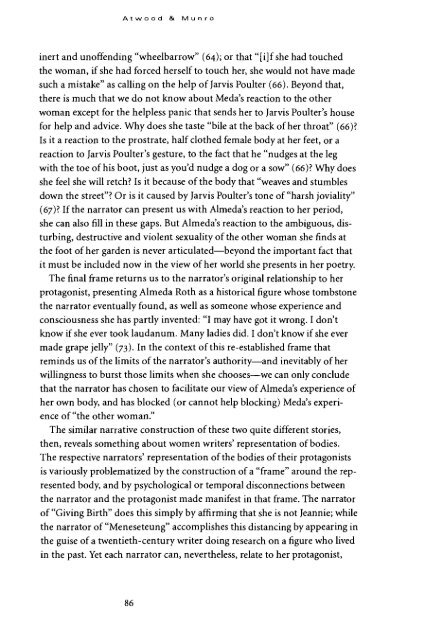A Quarterly of Criticism and Review i^^^^^^^^fcEjfc $15
A Quarterly of Criticism and Review i^^^^^^^^fcEjfc $15
A Quarterly of Criticism and Review i^^^^^^^^fcEjfc $15
You also want an ePaper? Increase the reach of your titles
YUMPU automatically turns print PDFs into web optimized ePapers that Google loves.
A t w o o d 8* Munroinert <strong>and</strong> un<strong>of</strong>fending "wheelbarrow" (64); or that "[i]f she had touchedthe woman, if she had forced herself to touch her, she would not have madesuch a mistake" as calling on the help <strong>of</strong> Jarvis Poulter (66). Beyond that,there is much that we do not know about Meda's reaction to the otherwoman except for the helpless panic that sends her to Jarvis Poulter's housefor help <strong>and</strong> advice. Why does she taste "bile at the back <strong>of</strong> her throat" (66)?Is it a reaction to the prostrate, half clothed female body at her feet, or areaction to Jarvis Poulter's gesture, to the fact that he "nudges at the legwith the toe <strong>of</strong> his boot, just as you'd nudge a dog or a sow" (66)? Why doesshe feel she will retch? Is it because <strong>of</strong> the body that "weaves <strong>and</strong> stumblesdown the street"? Or is it caused by Jarvis Poulter's tone <strong>of</strong> "harsh joviality"(67)? If the narrator can present us with Almeda's reaction to her period,she can also fill in these gaps. But Almeda's reaction to the ambiguous, disturbing,destructive <strong>and</strong> violent sexuality <strong>of</strong> the other woman she finds atthe foot <strong>of</strong> her garden is never articulated—beyond the important fact thatit must be included now in the view <strong>of</strong> her world she presents in her poetry.The final frame returns us to the narrator's original relationship to herprotagonist, presenting Almeda Roth as a historical figure whose tombstonethe narrator eventually found, as well as someone whose experience <strong>and</strong>consciousness she has partly invented: "I may have got it wrong. I don'tknow if she ever took laudanum. Many ladies did. I don't know if she evermade grape jelly" (73). In the context <strong>of</strong> this re-established frame thatreminds us <strong>of</strong> the limits <strong>of</strong> the narrator's authority—<strong>and</strong> inevitably <strong>of</strong> herwillingness to burst those limits when she chooses—we can only concludethat the narrator has chosen to facilitate our view <strong>of</strong> Almeda's experience <strong>of</strong>her own body, <strong>and</strong> has blocked (or cannot help blocking) Meda's experience<strong>of</strong> "the other woman."The similar narrative construction <strong>of</strong> these two quite different stories,then, reveals something about women writers' representation <strong>of</strong> bodies.The respective narrators' representation <strong>of</strong> the bodies <strong>of</strong> their protagonistsis variously problematized by the construction <strong>of</strong> a "frame" around the representedbody, <strong>and</strong> by psychological or temporal disconnections betweenthe narrator <strong>and</strong> the protagonist made manifest in that frame. The narrator<strong>of</strong> "Giving Birth" does this simply by affirming that she is not Jeannie; whilethe narrator <strong>of</strong> "Meneseteung" accomplishes this distancing by appearing inthe guise <strong>of</strong> a twentieth-century writer doing research on a figure who livedin the past. Yet each narrator can, nevertheless, relate to her protagonist,86
















